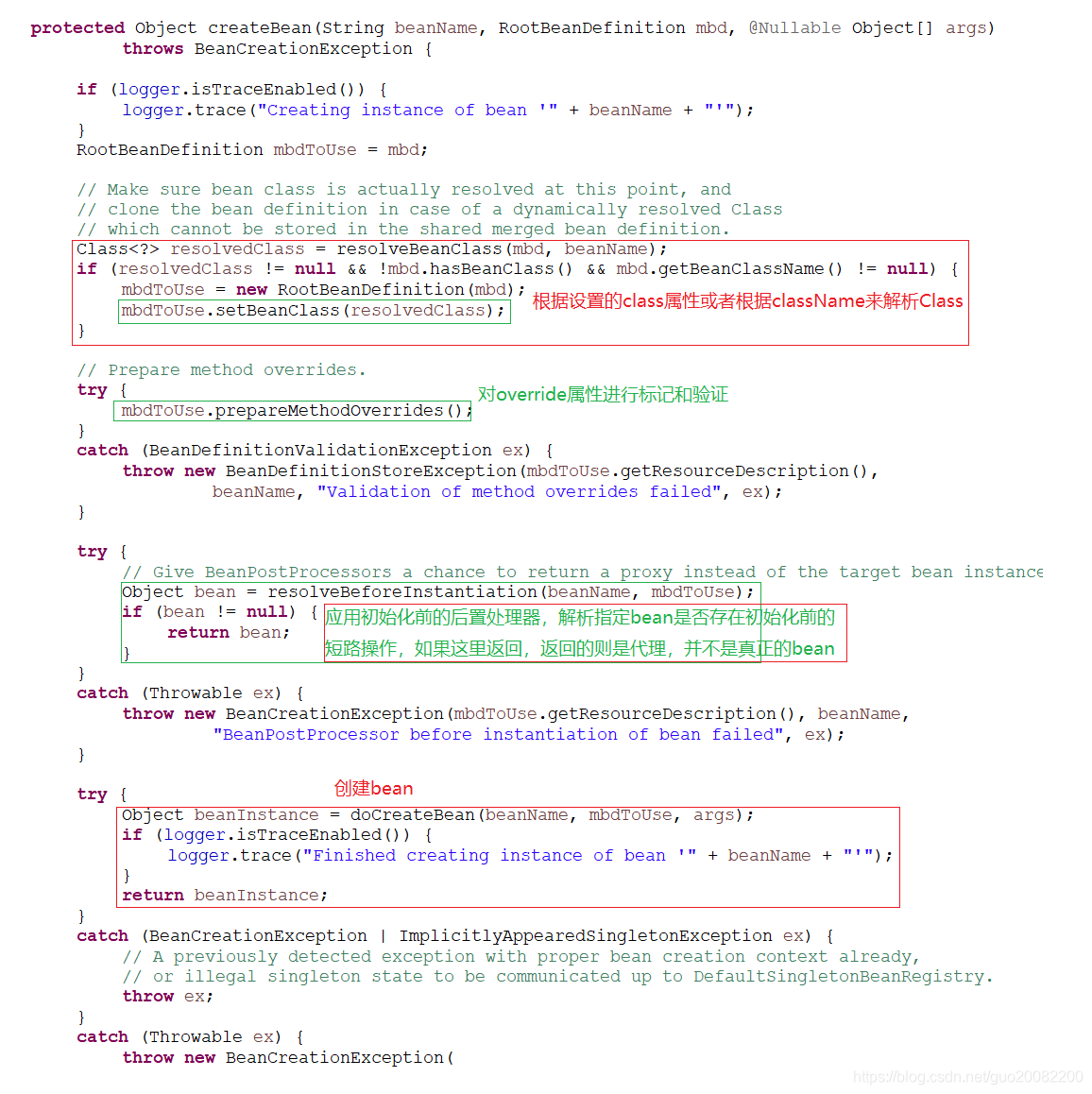spring原始碼分析六 bean的載入第三步-單例的建立 上篇
阿新 • • 發佈:2018-12-19
在上一篇部落格中有單例建立的如下程式碼:
if (mbd.isSingleton()) {
sharedInstance = getSingleton(beanName, () -> {
try {
return createBean(beanName, mbd, args);
}
catch (BeansException ex) {
// Explicitly remove instance from singleton cache: It might have been put there
// eagerly by the creation process, to allow for circular reference resolution. 整個邏輯比較簡單,
- getSingleton 獲取到物件,方法裡面傳遞ObjectFactory物件
- 呼叫createBean(beanName, mbd, args)的方法
- 建立bean失敗的話就銷燬bean,呼叫destroySingleton(beanName);方法
這裡先解是為什麼建立失敗要銷燬bean?這裡要顯示的從快取中移除掉建立失敗的bean,這是因為在建立過程中,可能已經將該bean建立了放到了快取中,為了解決迴圈依賴的問題。這裡不僅僅要移除該bean,並且將依賴該bean的其他的所有的bean都要移除。具體原始碼的分析這裡就略去了。
下面分析 getSingleton 的原始碼:

下面分析createBean(beanName, mbd, args)方法
org.springframework.beans.factory.support.AbstractAutowireCapableBeanFactory.java

先看如下的方法:mbdToUse.prepareMethodOverrides();
public void prepareMethodOverrides() throws BeanDefinitionValidationException {
// Check that lookup methods exists. 再看Object bean = resolveBeforeInstantiation(beanName, mbdToUse);
protected Object resolveBeforeInstantiation(String beanName, RootBeanDefinition mbd) {
Object bean = null;
if (!Boolean.FALSE.equals(mbd.beforeInstantiationResolved)) {
// Make sure bean class is actually resolved at this point.
if (!mbd.isSynthetic() && hasInstantiationAwareBeanPostProcessors()) {
Class<?> targetType = determineTargetType(beanName, mbd);
if (targetType != null) {
bean = applyBeanPostProcessorsBeforeInstantiation(targetType, beanName);
if (bean != null) {
bean = applyBeanPostProcessorsAfterInitialization(bean, beanName);
}
}
}
mbd.beforeInstantiationResolved = (bean != null);
}
return bean;
}
protected Object applyBeanPostProcessorsBeforeInstantiation(Class<?> beanClass, String beanName) {
for (BeanPostProcessor bp : getBeanPostProcessors()) {
if (bp instanceof InstantiationAwareBeanPostProcessor) {
InstantiationAwareBeanPostProcessor ibp = (InstantiationAwareBeanPostProcessor) bp;
Object result = ibp.postProcessBeforeInstantiation(beanClass, beanName);
if (result != null) {
return result;
}
}
}
return null;
}
public Object applyBeanPostProcessorsAfterInitialization(Object existingBean, String beanName)
throws BeansException {
Object result = existingBean;
for (BeanPostProcessor processor : getBeanPostProcessors()) {
Object current = processor.postProcessAfterInitialization(result, beanName);
if (current == null) {
return result;
}
result = current;
}
return result;
}
